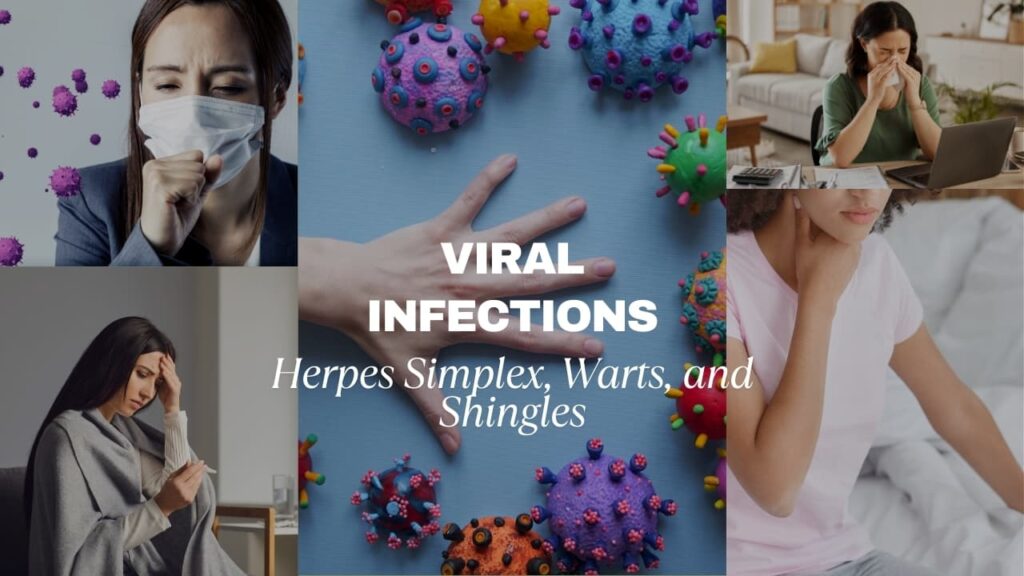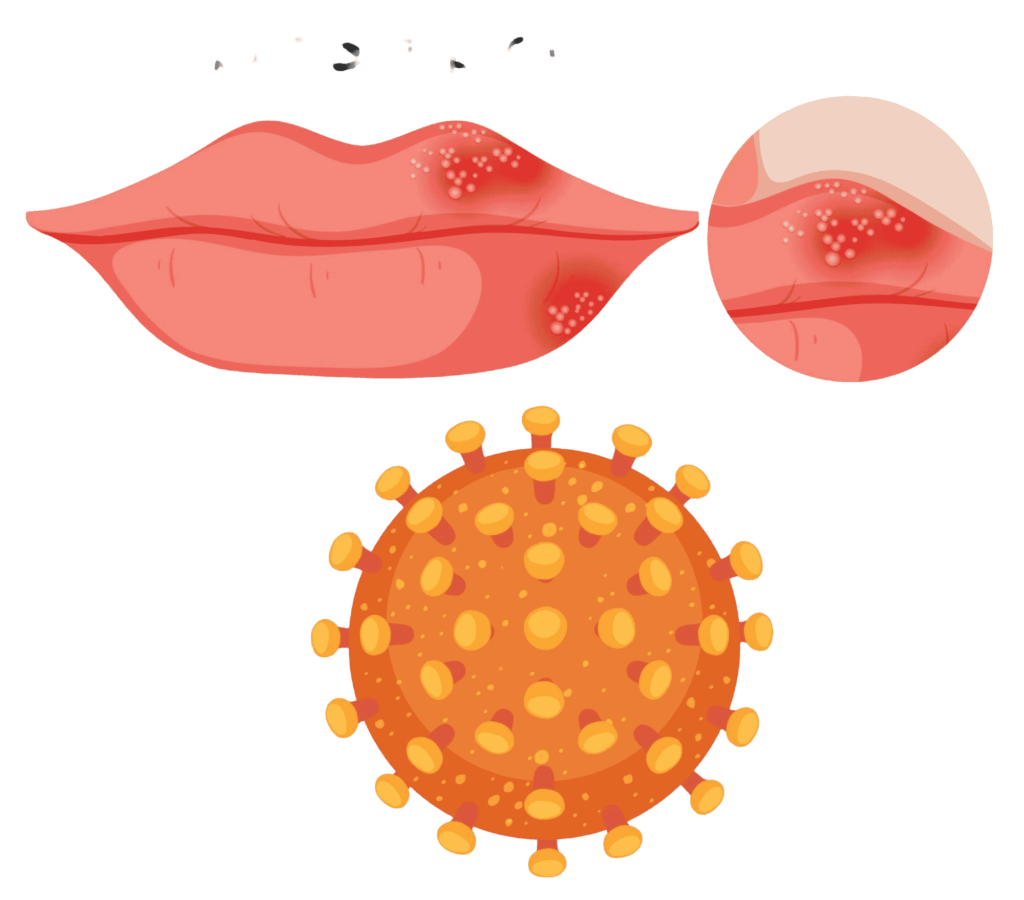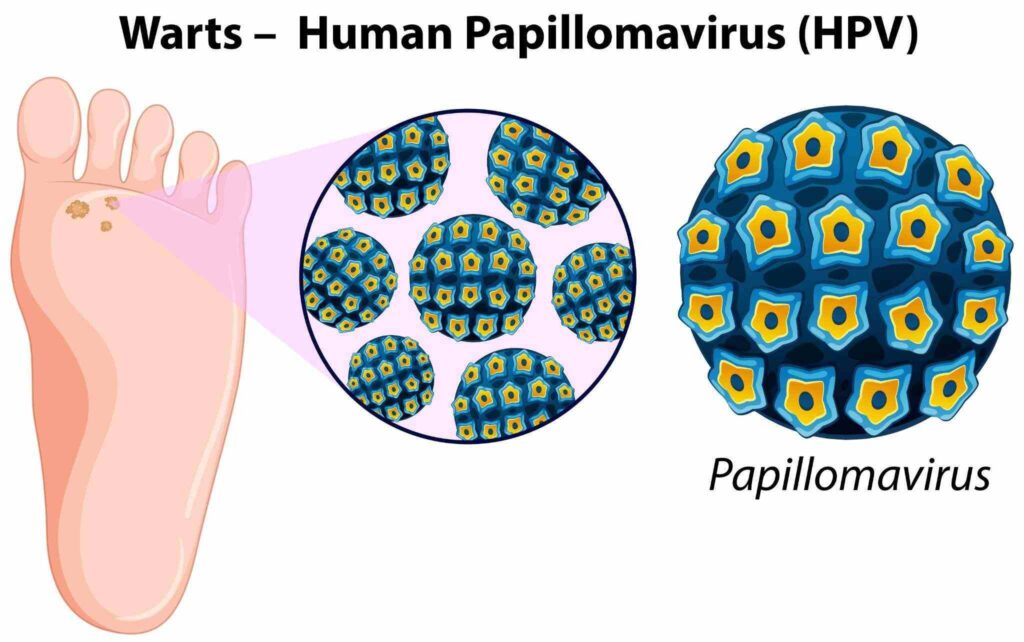Last updated on May 20th, 2025 at 05:25 pm
 Viral infections are among the most common health concerns across the globe. Although some viral infections can be quite mild and self-limiting, others may present as chronic, thereby requiring proper medical attention. Among such infections are herpes simplex, warts, and shingles – three viral infections affecting millions of people worldwide. This blog delves into the depth of these infections, including their causes, symptoms, treatment options, and potential complications.
Viral infections are among the most common health concerns across the globe. Although some viral infections can be quite mild and self-limiting, others may present as chronic, thereby requiring proper medical attention. Among such infections are herpes simplex, warts, and shingles – three viral infections affecting millions of people worldwide. This blog delves into the depth of these infections, including their causes, symptoms, treatment options, and potential complications.
Herpes Simplex Virus (HSV)
Herpes simplex virus (HSV) is a viral infection that causes sores and blisters on the skin, mucous membranes, and sometimes internal organs. There are two main types of the herpes simplex virus: HSV-1 and HSV-2.
- HSV-1 primarily causes oral herpes, leading to painful cold sores around the mouth and lips.
- HSV-2 is usually associated with genital herpes, though HSV-1 can also cause genital outbreaks.

Symptoms
The symptoms of herpes simplex infections vary depending on the type of virus and location of the breakout. The most common viral infection symptoms include:
- Sores or blisters, which most of the times appear close to the mouth, mouth, genital region, and eyes.
- Pain or burning or itching sensations: Before the sores break out.
- Swollen lymph nodes due to the immune response the body has to the virus.
Some people may also have fever, muscle aches, and fatigue during an outbreak.
Treatment
There is no cure for herpes simplex, but antiviral drugs can help control the symptoms and reduce the frequency of outbreaks. Some of the common antiviral drugs for herpes simplex are acyclovir, valacyclovir, and famciclovir.
In the case of oral herpes, or HSV-1, antiviral medication reduces the severity and duration of outbreaks. In the case of genital herpes, or HSV-2, antiviral medications may reduce the shedding of the virus and the potential to transmit it to another person.
Antiviral creams and ointments are also applied topically to provide relief from the pain and discomfort of herpes sores.
Herpes Simplex Images
- Herpes simplex pictures demonstrate small, fluid-filled blisters that break open and form painful ulcers.
- Viral infection in mouth pictures often show the sores or blisters of cold sore caused by HSV-1 that appear on or around the lips.
Warts
Warts are benign epithelial growths that are due to human papillomavirus (HPV). Over 100 types of HPV are known, and it infects different parts of the body, leading to various types of warts.
- Common warts are typically found on the hands and fingers.
- Plantar warts appear on the soles of the feet.
- Genital warts occur in the genital region.
- Flat warts present as small, smooth growths, typically on the face or legs.
Symptoms
Warts are typically painless but may become uncomfortable or unsightly when they occur in areas that experience friction. Common symptoms include:
- Elevated, papillated papules: These can be located on the skin and vary in size and shape.
- Alterations in skin texture: Warts can be rough or smooth depending on the type
- Pain/discomfort: Especially for plantar warts, which may cause pain when walking.
Treatment
Although warts can resolve on their own, medical treatment is required if the lesions are painful, spreading, or embarrassing. Several viral infection treatments are available, including
- Topical treatments: Salicylic acid or freezing the wart can be bought in most drugstores over the counter.
- Laser therapy: If the warts do not go away, a laser is used to burn out the tissue.
- Surgical removal: Warts might need to be surgically removed.
As the virus that causes warts is extremely contagious, proper hygiene and keeping hands away from touching warts is necessary to decrease the chance of infection spreading.
Pictures of Warts
Pictures of warts often showcase raised, rough bumps on the skin. Warts on the face are typically flat, small, and smooth in appearance, while plantar warts can be more calloused and painful.

Shingles (Herpes Zoster)
Shingles, also known as herpes zoster, is a viral infection caused by the reactivation of the chickenpox virus, varicella-zoster. It means that after a person has overcome chickenpox, the virus lies dormant in the nerve cells and reactivates later in life as shingles.
Shingles mostly occurs in adults, especially those over 50 years of age. The pain and discomfort can be significant. The rash is often in the form of a band or strip of blisters on one side of the body.
Symptoms
The symptoms of shingles can be intense and varied between people. Common viral infection symptoms of shingles include:
- Pain or tingling : Usually localized and sometimes preceding the rash by days.
- Rash and blisters : The rash usually presents in a band-like distribution, often across the chest, back, or face.
- Fever and fatigue : Many individuals have a mild fever, fatigue, and general unwellness.
Sometimes, shingles can lead to complications, such as herpes zoster ophthalmicus, which affects the eye and can result in vision loss if not treated promptly.
Treatment
There is no cure for shingles, but antiviral drugs can be used to hasten recovery and reduce the severity of symptoms. Some common herpes zoster treatments are:
- Acyclovir : It is one of the most commonly used antiviral drugs that can lessen the severity and duration of shingles.
- Valacyclovir : This is another antiviral drug that works similarly to acyclovir but is easier to take.
Pain management should be addressed, and drugs including corticosteroids or analgesics can be recommended to control the pain.
For those at risk of developing shingles, the vaccines are provided to reduce the chance of getting the infection. The vaccine for the shingles virus, especially among those over 50, can reduce the chances of a person getting the infection by a great margin.
Herpes Zoster Ophthalmicus
This particular type of shingles impacts the eye and thus brings about pain, redness, and swelling. Lack of proper treatment leads to lifelong vision problems; this calls for early intervention.
Shingles Pictures
These shingles pictures usually have an appearance of a band of rash usually on the torso and sometimes on the face which may be very painful and aesthetically unpleasing.
Herpes Zoster and Harpist Disease
While harpist disease is a relatively rare condition that can be related to herpes zoster in some cases, it generally refers to a particular neurological problem associated with shingles. This disease may involve nerve damage that affects the skin’s sensation and can cause chronic pain after the rash has healed. This condition is more commonly known as postherpetic neuralgia (PHN), which is one of the most common complications of shingles.
Viral Infection Of Mouth
A viral infection in the mouth is typically caused by viruses such as herpes simplex virus (HSV), which leads to cold sores or oral herpes, or the human papillomavirus (HPV), which can cause warts in the mouth. Symptoms of viral infections in the mouth include painful sores, blisters, swelling, redness, and sometimes fever or a sore throat. The infection can be contagious, often spreading through direct contact. Treatment focuses on antiviral medications to manage symptoms and prevent outbreaks, while maintaining good oral hygiene is essential to reduce irritation and prevent further complications.
Difference Between Viral And Bacterial Infection
The main difference between viral and bacterial infections lies in their causes and treatment. Viruses are microscopic agents that require a host cell to reproduce and cause disease, and they cannot be treated with antibiotics. Examples include the flu, cold sores, and COVID-19. Bacteria, on the other hand, are single-celled organisms that can reproduce on their own and are often treated with antibiotics. While some bacteria are harmful and cause infections like strep throat or tuberculosis, many are beneficial and live in the body, aiding in processes like digestion. Proper diagnosis is essential for appropriate treatment.
Conclusion
Viral infections like herpes simplex, warts, and shingles are problematic. However, appropriate treatment minimizes symptoms of these conditions and prevents further infection from spreading. It’s essential to recognize the signs of these infections early, follow the recommended treatment protocols, and take steps to prevent further outbreaks or complications. Whether you are dealing with cold sores, warts, or the painful rash of shingles, professional medical care can help you navigate the road to recovery.
FAQs On Viral Infections: Herpes Simplex, Warts, and Shingles
1. What is the difference between herpes simplex and shingles?
Herpes simplex by the HSV-1 or HSV-2 virus is the usually oral or genital sores. Shingles is, caused by the varicella-zoster virus it is a reactivation of the chickenpox virus in the body and produces severe rash on one side of the body. Both are virus infections but different in their own symptoms and origin.
2. How do I not let warts spread?
Avoid touching or scratching warts and cover them to prevent the spread of warts. Maintain good hygiene by washing hands often and avoid sharing personal items such as towels or razors. Infected areas should be treated with over-the-counter medications or by a healthcare provider for proper removal.
3. Can shingles be treated with antiviral medications?
Yes, antiviral drugs such as acyclovir or valacyclovir can be used to treat shingles. This reduces the severity and duration of the infection. Treatment should be initiated within 72 hours of the onset of the rash to prevent postherpetic neuralgia complications. Pain relievers are also prescribed for relief.
Related Links :